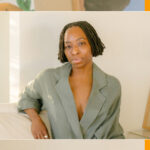Eun Sun Kim
Music Director
-
Nightly Routine

What do metals and Eun Sun Kim (she / her) have in common?
They’re both phenomenal conductors, and while Eun isn’t transferring electricity, she did spark a shift in the classical industry by becoming San Francisco Opera’s first female music director.
Ahead of her current stint conducting La Bohème in Vienna, we talked to the South Korean native (who can speak 6 languages, BTW) about getting ready for a night behind the podium, why conducting could be the new cardio, and why heels=hell in her line of work.
4 P.M. I study the score for the evening. Although we have rehearsed for 6 weeks, the interpretation changes every day, because we as human beings change every day. It’s like when you’ve read a good book 30 times. Although you already know what’s going to happen, it feels fresh and different every single time. So I go through my scores for 2-3 hours, then I go backstage.
6:30 P.M. I visit all the singers to see how they are. If they’re tired or have concerns, then you know how to work with them on that day. Thirty minutes later, the music and other stage staff come to the conductor’s room to check in with me about the timing or whatever else. You wait until they call you, then you go into the pit.
7:30 P.M. It’s all music in my brain and how to drive the music. Whether it’s symphony or opera, there is storytelling [and] it all depends on the chemistry between me, the orchestra, and the singers. You cannot replicate anything we did last time or even a minute ago… Although we rehearse and say “this transition is going to be this,” sometimes… you can’t verbally explain it, but there is a moment where everybody feels the same thing, then you make a change. The interaction with the audience [matters] as well. If it’s an opera and we hear a lot of laughter or applause, then we get more excited and that changes the tempo.
8:30 P.M. My shoulders start to feel tired. And my thighs! You have to stand for, like, 3 hours, so I do stretches before and after. There are women conductors who wear high heels during concerts. I tried that once when I was a student, but I’m not stable enough [laughing]. My teacher at the time said I was leaning forward, so I just got rid of that.
10 P.M. I’m wrapping up the show. I can’t gauge the volume of applause when I’m going out. When you’re thinking of something, your ear is not gathering [precise] information, and when I point out the orchestra, I’m thinking, “Oh, I have to do [this] next,” so I don’t actually hear the reaction. For me, it’s not about applause at the end of the performance. It’s more about during the show that I feel that energy.
11 P.M. I don’t think there is any artist who can go to bed right after the performance, because you need time to get out of this adrenaline [state]. It takes 3-4 hours for me. I have to do emails and that kind of stuff. But otherwise, I just watch Netflix or do a completely different thing. I don’t listen to music for pleasure at home, because then I start immediately analyzing. I like when I’m invited to someone’s home and they put on quiet jazz as background music. But if it gets louder, it becomes work.



